10 Species of Woodpeckers In Wisconsin (with Pictures)
Last Updated on
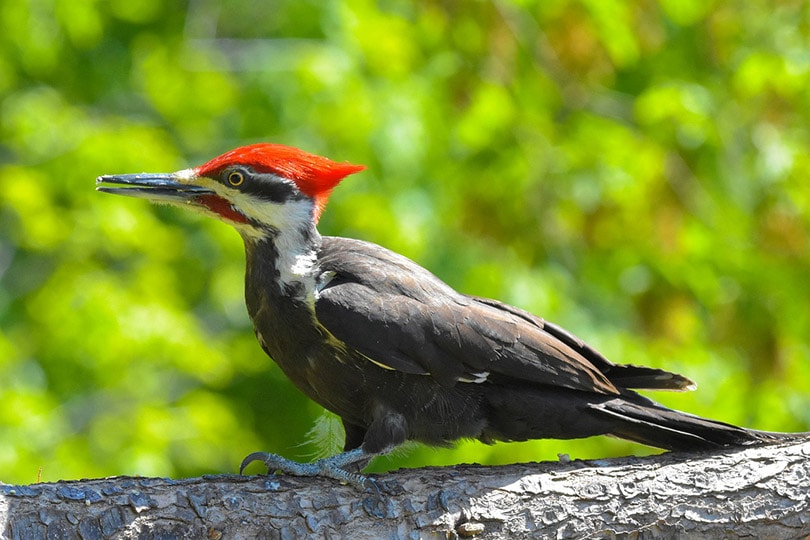
Bird watchers often hear woodpeckers before they see them. Unlike the lyrical calls of songbirds, many woodpeckers make their presence known with rhythmic drumming noises. They tap their beaks against a tree or even a metal post.
Eight of the birds on our list have a consistent presence in Wisconsin. Some live here all year, while others migrate to warmer states during the winter. While the remaining two breeds live outside of the state, there have been sporadic sightings.

The 10 Species of Woodpeckers in Wisconsin
1. Pileated Woodpecker
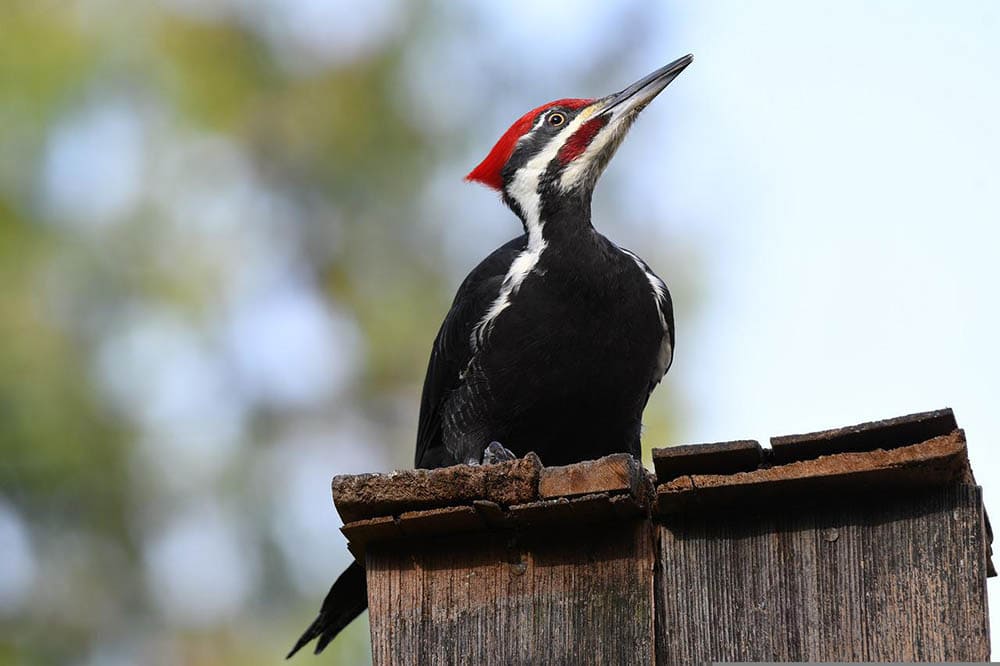
| Distinguishing Physical Characteristics | Both sexes have a red crest |
| Body Length | 15.8–19.3 inches |
| Mate for Life? | Yes |
| Migrate Out of Wisconsin? | No |
The Pileated woodpecker’s diet consists mainly of carpenter ants and the larvae of wood-boring beetles. To get at their food, the woodpeckers burrow out rectangular holes in trees. With a wingspan of 2.25 feet, these are good-sized birds need larger trees to nest in, but their habitat has been reduced by the timber industry.
In the early 1900s, people hunted the woodpeckers, but the practice is now outlawed. Pileated Woodpeckers are somewhat evasive, but you can attract some to your birdfeeder by offering suet. Their red crest, which resembles a bright red mohawk, is easy to see.
2. Northern Flicker

| Distinguishing Physical Characteristics | Red-shafted Flickers have bright red feathers under their wings |
| Body Length | 11.0–12.2 inches |
| Mate for Life? | Yes |
| Migrate Out of Wisconsin? | No. The northern half of the state is the breeding territory, but Flickers are present all year in the southern half. |
Birdwatchers in Wisconsin are more likely to see a Yellow-shafted flicker, since the Red-shafted flickers stick to the western half of the country. In the Plains region, the territories of the Yellow and Red flickers overlap, and these birds will interbreed.
The Northern flickers are adaptable birds that will nest anywhere there are trees. The flickers are natural foragers who eat ants, beetles, fruits, and seeds. They favor trees near open ground over dense, heavily wooded forests.
3. Yellow-bellied Sapsucker

| Distinguishing Physical Characteristics | Red forehead and throat |
| Body Length | 7.1–8.7 inches |
| Mate for Life? | Sometimes |
| Migrate Out of Wisconsin? | Yes |
The Yellow-bellied sapsuckers are meticulous eaters. As their name suggests, they favor tree sap. After a meal, these birds leave behind rows of evenly spaced holes in tree trunks. Sapsuckers will also forage for ants, berries, and fruit. In the winter, they may congregate in orchards where they can feed off the fruit.
Although you won’t hear them singing in the winter, sapsuckers are quite noisy in the spring. They have feline-like calls and enjoy drumming their beaks, even when they’re not searching for food.
4. Black-backed Woodpecker
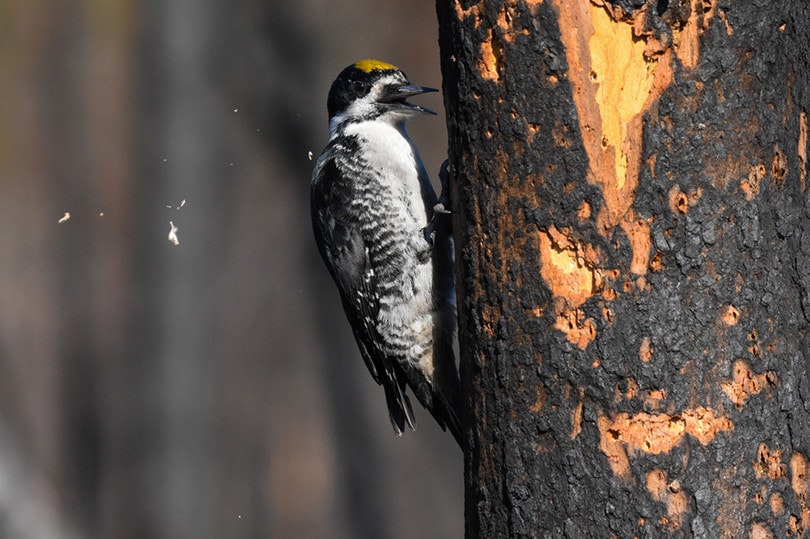
| Distinguishing Physical Characteristics | Yellow crown patch on adult males and juveniles of both sexes |
| Body Length | 9 inches |
| Mate for Life? | Sometimes |
| Migrate Out of Wisconsin? | No |
Areas that have had recent forest fires may see a spike in Black-backed woodpecker populations. These birds forage for larvae in burned trees. They will also search for meals in trees that have died due to pest infestations. Once the birds find a steady food source, they will stay put for several years.
Black-backed woodpeckers live in the northern portion of the state. After they abandon their nest holes, other birds like chickadees and owls move in. The woodpecker’s name is fitting, as birds of both sexes look like they wear a black cape.
5. Downy Woodpecker
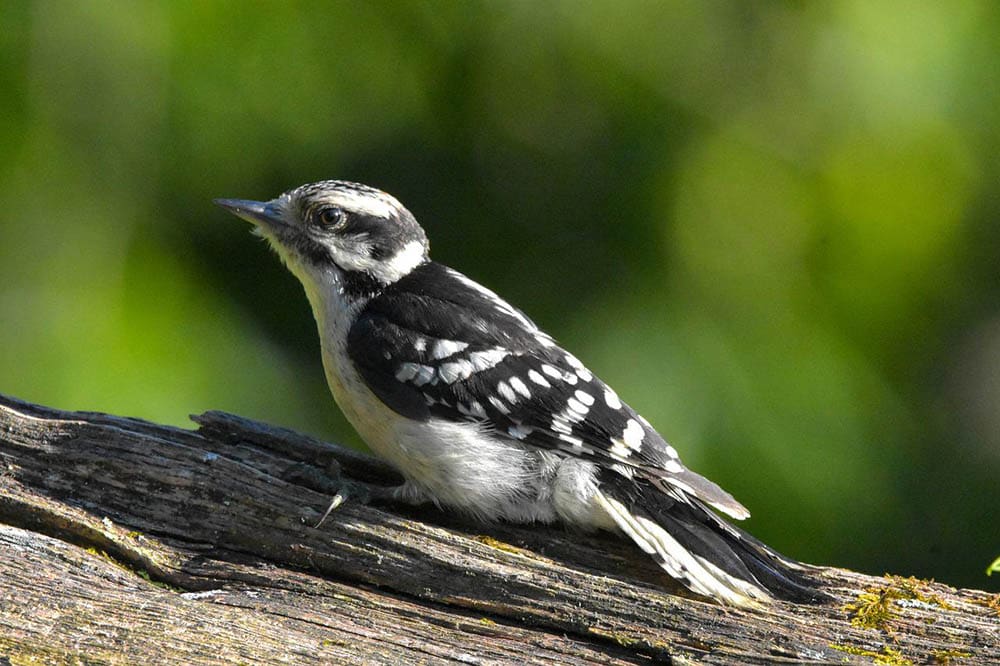
| Distinguishing Physical Characteristics | Black and white checkered wings |
| Body Length | 5.5–6.7 inches |
| Mate for Life? | Pairs mate for more than one season |
| Migrate Out of Wisconsin? | No |
The Downy woodpecker has a year-round presence throughout almost all of Canada and the United States. They primarily eat beetles, ants, wasps, caterpillars, berries and seeds, but you can attract them to your bird feeder with suet and peanuts.
They are smaller than the Hairy woodpeckersbut look very much alike. Unlike their larger cousins, Downy birds are able to forage on smaller branches and hang upside down. Downy woodpeckers live in harmony with other birds, and you can often spot them in multi-species flocks.
6. Hairy Woodpecker
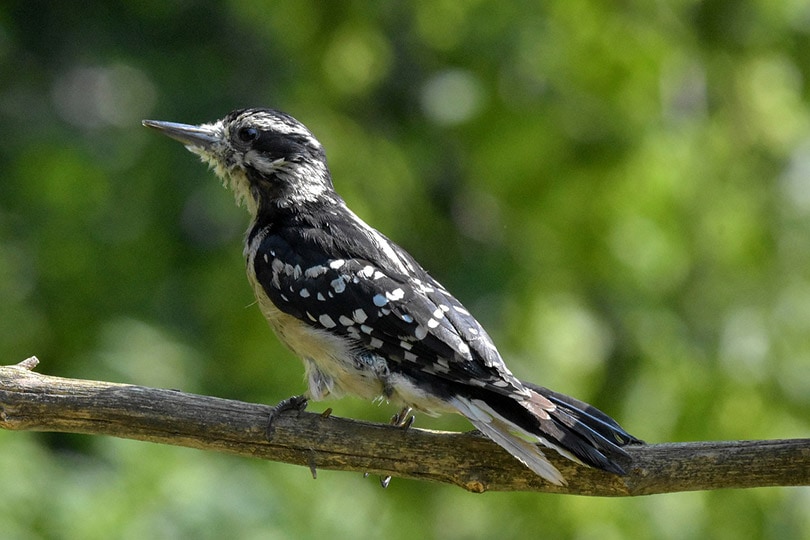
| Distinguishing Physical Characteristics | Black and white checkered wings, with a large white patch on the back |
| Body Length | 7.1–10.2 inches |
| Mate for Life? | Often |
| Migrate Out of Wisconsin? | No |
Newer bird watchers may confuse the Hairy woodpecker with its smaller look-alike twin, the Downy woodpecker. These birds adapt easily and live anywhere there are large trees. The Hairy woodpecker has habitats in Central America and North America.
They mainly feast on insects and sap, but they will come to bird feeders to nibble on suet, peanuts, and black oil sunflower seeds. If you have a dead tree on your property or a living one with dying sections, you may be lucky enough to spot a Hairy woodpecker couple construct a nest there.
7. American Three-Toed Woodpecker

| Distinguishing Physical Characteristics | Juveniles and adults have a yellow crown patch |
| Body Length | 8.3–9.1 inches |
| Mate for Life? | No |
| Migrate Out of Wisconsin? | Only spotted in the Superior area, but may wander large distances for food |
Wisconsin is just south of the American Three-toed woodpecker’s range. But these birds have been spotted along the Lake Superior shoreline, near the city of Superior and the Apostle Islands. The American Three-toed woodpeckers are solitary birds. They spend much of their lives by themselves, foraging for food. They pair up only during the mating season.
They often swoop in and assemble in forests after a flood or fire. They are also commonly seen in areas plagued by wood-boring insects. Three-toed birds are capable of stripping all of the bark off of a tree as they forage for food. In addition to insects, they eat sap and some fruit.
8. Red-bellied Woodpecker
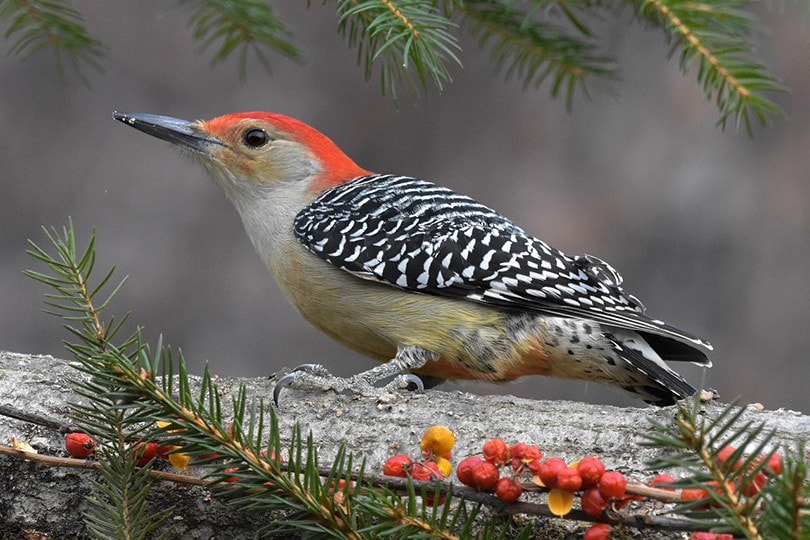
| Distinguishing Physical Characteristics | Males have a red nape and crown, while adult females have only a red nape |
| Body Length | 9.4 inches |
| Mate for Life? | Yes |
| Migrate Out of Wisconsin? | No |
The Red-bellied woodpecker has been spotted throughout the state. The name is somewhat deceptive, as its red head is what bird watchers will notice first. This bird’s belly is actually a pale red mottled with white. These birds are not picky eaters. They will dine on insects, spiders, lizards, and minnows. Asomnivores, they will also eat seeds, fruits, and pinecones.
The Red-bellied woodpecker is a bit of a bully and has been known to prey on nestlings. It will also scare away most other species at a bird feeder.
9. Red-headed Woodpecker
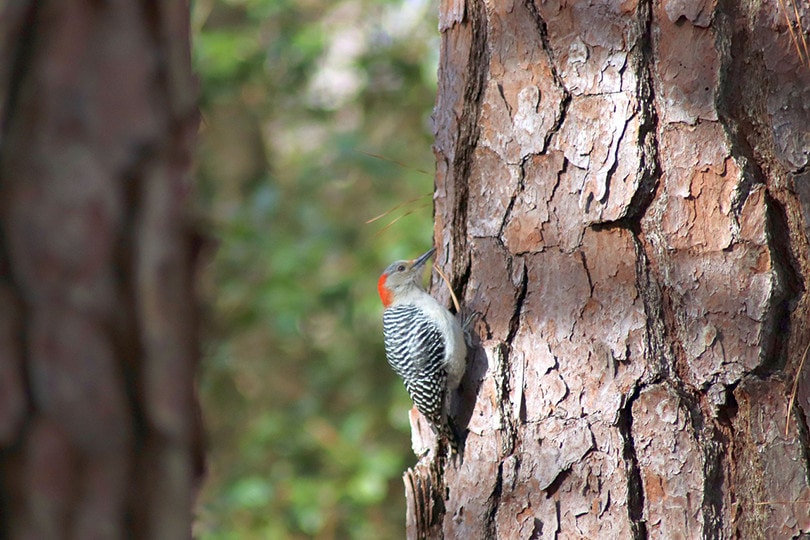
| Distinguishing Physical Characteristics | Female and male adults have bright red heads |
| Body Length | 7.5–9.1 inches |
| Mate for Life? | Sometimes. Pairs will often mate for several years. |
| Migrate Out of Wisconsin? | Yes, short distances |
The Red-headed woodpecker is unique in that the adults of both sexes look alike. They are visually stunning birds that are easy to spot. The tri-colored woodpeckers have all-red heads, a whitebellies, and black wings.
The Red-headed woodpecker population has declined in recent years. This is probably due to the removal of dead trees, which are the birds’ main nesting areas. The bird is an aggressive omnivore that will prey on small rodents, nestlings, and eggs.
10. Lewis’s Woodpecker
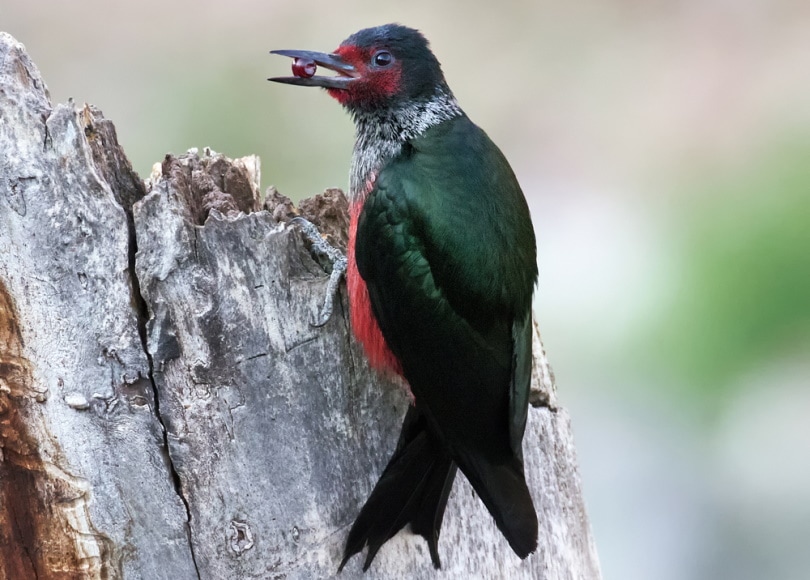
| Distinguishing Physical Characteristics | Iridescent black and green backs |
| Body Length | 10.2–11.0 inches |
| Mate for Life? | Yes, and may use the same nest more than once |
| Migrate Out of Wisconsin? | Only spotted in the far northern portion of the state |
This woodpecker is named after Meriwether Lewis, who reportedly first saw the bird in 1805. Lewis’s woodpeckers have dark green plumage, gray collars, and pink bellies. Unlike most woodpeckers, they’re skilled at catching insects in the air. A Lewis’s woodpecker sighting in Wisconsin is rare, but the birds typically occupy the western half of the country.
However, there have been reported sightings along the Superior shoreline and Michigan’s Upper Peninsula border. They are nomadic, so it’s possible they traveled east in search of food. Lewis woodpeckers eat flying insects, acorns, and nuts.

In Conclusion
Only the luckiest of Wisconsinites will see an American Three-toed woodpecker or Lewis’s woodpecker. Those birds do not have a consistent presence in the state, but bird watchers can count on seeing Pileated woodpeckers and Hairy woodpeckers all year long. Many species of Wisconsin woodpeckers will come to backyard bird feeders to dine on suet, nuts, and fruit.
Featured Image Credit: JackBulmer, Pixabay
Table of Contents
About the Author Cameron Porter
Cameron is a husband and father of three. He has built and sold a video production business and has been an imaging and optics enthusiast for over a decade. He loves the outdoors and prefers mountain hikes over walks on the beach. He enjoys building furniture and camping in his spare time.
Related Articles:
Monocular vs Telescope: Differences Explained (With Pictures)
How to Choose Binoculars for Bird Watching: 10 Expert Tips
10 Types of Hummingbirds in Arkansas (With Pictures)
8 Types of Hummingbirds in Nebraska (With Pictures)
5 Types of Hummingbirds in Idaho (With Pictures)
3 Types of Hummingbirds in Mississippi (With Pictures)
8 Types of Hummingbirds in Kansas (With Pictures)
5 Types of Hummingbirds in West Virginia (With Pictures)
